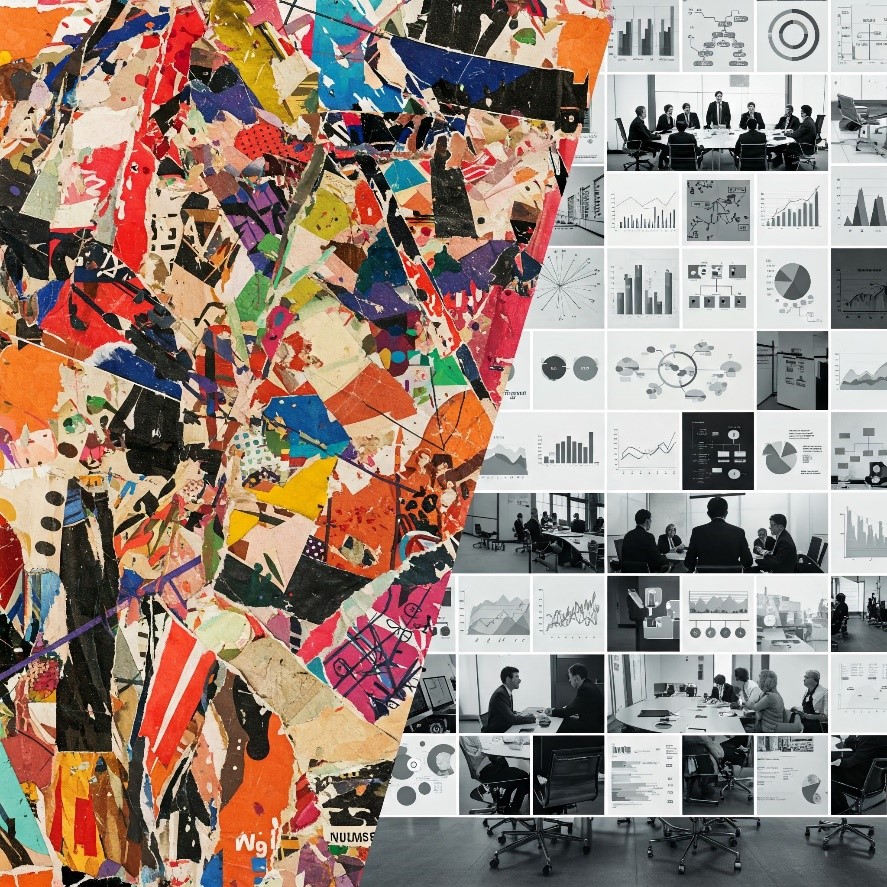
SUMMARY
Visuals have the potential to further open our understanding of organizational life to its complex messiness. However, this potential is not always fully realized in visual management studies. Through a problematizing review of the existing research field, this study discusses how a critical approach to visual research, that embraces messiness, can provide more insightful understandings of organizational dynamics.
INTRODUCTION
Management studies often seek order and clarity, which can be at odds with the messy, complex realities of organizational life. However, visual management studies (VMS) offers an opportunity to explore the ambiguous, sensory, and often contradictory aspects of organizations. Visuals, including images, videos, and even architecture, have a ‘messy potential’ to address these complexities. Despite this potential, there is a risk that VMS may fall into standardized methods of inquiry, missing out on the rich insights that a truly messy approach can offer.
OUR PROBLEMATIZING REVIEW AND THE THREE RESEARCH QUESTIONS
This study conducts a problematizing review, building on a method proposed by Alvesson and Sandberg (2020) to investigate how VMS engages with the inherent messiness of organizational life. Unlike traditional reviews that aim to synthesize knowledge, a problematizing review critically examines the underlying assumptions and norms within a field, aiming at ‘challenging and reimagining our current ways of thinking’. To achieve this re-imagining aim, our adaptation of the problematizing review employs a multi-level approach. We delve into readings on 1) the conceptual motivation of messiness, 2) visual studies, and 3) reflexivity, juxtaposing them with empirical VMS. This multi-level approach informs our critical questioning of VMS: How is the visual conceptualized? How is visual meaning decided? And how is the visual researcher depicted? Our analysis yields the following key findings.
HOW IS THE VISUAL CONCEPTUALIZED?
We found that the visual is conceptualized in three different ways in VMS, each enacting different types of realities:
- The visual as a facet: Here, the visual is recognized as an important part of organizational life, working alongside the verbal. However, studies tend to analyze visual data through a verbal or numerical logic, potentially missing some of its messy potential.
- The visual as an enabler: In this approach, visuals are used to understand unspeakable or unnoticed experiences, such as emotions and identity struggles. While this approach acknowledges complexity, the visual is still treated as a tool, rather than a co-constituting force.
- The visual as a co-constituting force: This perspective recognizes that the visual is integral to how organizations are constituted. Visuals are not just a reflection of reality but an irreducible force that actively shapes it with unique logics. This approach, we argue, is best equipped to deal with messiness.
HOW IS VISUAL MEANING DECIDED?
Our review revealed three ways visual meaning is determined in VMS:
- At the site of the image: Some studies analyze visual meaning by focusing solely on the image itself, using analytic methods such as visual grammar to break the image into components to decide its meaning.
- At multiple sites, with aligned meaning: Other studies consider visual meaning across production, circulation, and audience sites, but often assume a singular, convergent interpretation across all these sites.
- At the collapse of multiple sites, with negotiated meaning: In this approach, visual meaning is explored in the context of interactions where visual representations are used for negotiation and collaboration. However, this can overlook disagreement and the inherent messiness of visual interpretation.
We advocate for attending to the ‘inter-sitiuality’ of the visual, arguing that we should consider how visual meaning is always situated within a complex web of social relations, acknowledging that visuals never belong to just one site.
HOW IS THE VISUAL RESEARCHER DEPICTED?
Finally, we looked at how visual researchers present themselves in VMS:
- The authoritative researcher: This type of researcher establishes their authority through rigorous empirical methods or theoretical expertise, often obscuring their own positionality.
- The situated researcher: This type reflects on how their positionality may impact research choices. This can involve considering the relationship with research participants or the engagement with visual material itself. We encourage researchers to be reflexive of both.
WHAT ARE THE (ACTIONABLE) TAKEAWAYS?
To fully embrace the messy potential of VMS, the field should:
- Theorize the visual as a co-constituting force: VMS must recognize that visuals are active forces that shape organizations. The field thus requires engagement with theories that explicitly explore the visual to theorize the mutual constitution of visual and organization.
- Interpret visual meaning as multiple and ‘free-floating’: Researchers should understand visual meaning as dynamic and shifting across the sites of production, circulation, and audiencing, resisting the urge to see meaning as fixed within the image itself.
- Embrace the situated, responsible researcher: VMS researchers must acknowledge that they are a site of meaning-making, taking responsibility for their perspective and how it influences their interpretations, acting as an embodied, locatable researcher.
PRACTICAL IMPLICATIONS: EMBRACING THE MESSY POTENTIAL OF VISUALS IN ORGANIZATIONAL PRACTICE
Extending beyond academia, our problematizing review offers critical insights for practitioners and policymakers seeking to understand and utilize visuals more effectively and responsibly within organizational life and the broader public sphere. By translating our findings into actionable strategies, managers, communicators, and leaders across various sectors can move beyond superficial use of visuals to engage with their transformative—and often messy—potential.
First, practitioners must come to a conscious recognition that visuals are not merely passive tools for representing reality but active forces that co-constitute organizational identity, values, and practices. This necessitates intentional visual design. Organizations should invest in visual literacy, training teams to critically evaluate how logos, office layouts, or marketing materials enact specific realities. A company aiming to project innovation, for example, might prioritize dynamic, collaborative imagery in internal communications, while a healthcare provider focused on care could emphasize visuals of human connection over sterile efficiency. However, this strategic use of visuals also demands a deep ethical responsibility. For instance, as illustrated by our earlier study (Shao and Janssens, 2022), CSR videos do not merely communicate a company’s social responsibility efforts; they also actively shape power relations and public discourse. Therefore, organizations and policymakers must work to cultivate “visual accountability”, fostering dialogue between organizations, stakeholders and the public. This contributes to visual choices that are not only strategic but also ethically sound, moving beyond self-regulation to a more collaboratively responsible approach.
Second, practitioners should anticipate the fluidity of visual meaning. Visual meaning derives from its production, the image itself, circulation, and audiencing—sites that rarely align neatly. A recruitment ad intended to signal inclusivity might be interpreted as tokenism by some audiences, and a social media campaign’s imagery can be reinterpreted, remixed, and even parodied by audiences through ‘second creation’, potentially shifting its meaning entirely beyond the organization’s control. Such fluidity of visuals, we believe, highlights the importance of proactive visual engagement with stakeholders. Recognizing the inherent ambiguity of visual communication, organizations should actively seek diverse interpretations to identify potential unintended messages. This could require participatory approaches, such as collaborative design workshops, which can further surface plural meanings and foster ownership among diverse stakeholders. Importantly, even with these collaborative methods, practitioners have to acknowledge that they do not monopolize the visual meanings, not even as producers or active circulators. Instead, they should embrace the dynamic nature of interpretation, ready to adapt organizational communicative strategies in response to evolving audience perspectives.
Finally, reflexivity must be embedded as a core practice. Visual decisions are never neutral; they inherently reflect and reinforce the positionality of those who create and/or deploy them. Practitioners should interrogate how their roles, biases, and cultural backgrounds shape the visuals they endorse. For example, a leadership team dominated by a single demographic might inadvertently overlook imagery that alienates other groups. By normalizing “visual reflexivity” in teams—such as discussing how dashboard designs or office art reflect power dynamics, organization can not only make thoughtful visual decisions and improve communication, but also uncover hidden assumptions, build trust and create a more inclusive workplace. Meanwhile, transparency in visual decision-making, achieved through documenting the rationale behind visual outputs, fosters a culture of deliberate practice and accountability in visual communication.
In conclusion, embracing the messy potential of visuals requires a shift from treating them as creative tools for communication to recognizing them as dynamic catalysts for ethical engagement. By asking “What realities are we creating—and for whom?” rather than “Do these visuals look good?” organizations can foster adaptive, inclusive storytelling that resonates with diverse stakeholders and promotes meaningful dialogue.

0 Comments